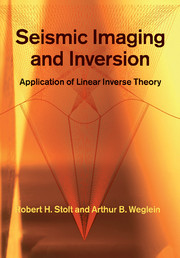Book contents
- Frontmatter
- Contents
- Preface and acknowledgments
- 1 Introduction – modeling, migration, imaging, and inversion
- 2 Basic migration concepts
- 3 Prestack migration
- 4 Migration limitations
- 5 Models for wave propagation and reflection
- 6 Green's functions
- 7 The scattering potential
- 8 Reflectivity
- 9 Synthesizing reflection data
- 10 Frequency–wavenumber migration
- 11 Asymptotic modeling and migration
- 12 Residual asymptotic migration
- 13 Asymptotic data mapping and continuation
- 14 Least-squares asymptotic migration
- Appendix A Conventions and glossary of terms
- Appendix B Coordinates, vectors, and identities
- Appendix C Fourier and Radon transforms
- Appendix D Surface and pointwise reflectivity
- Appendix E Useful filters
- Appendix F The phase integral and the stationary phase approximation
- Appendix G The diffraction integral
- Appendix H Wave-based, ray-based, and reflector-based coordinates
- References
- Index
1 - Introduction – modeling, migration, imaging, and inversion
Published online by Cambridge University Press: 05 February 2012
- Frontmatter
- Contents
- Preface and acknowledgments
- 1 Introduction – modeling, migration, imaging, and inversion
- 2 Basic migration concepts
- 3 Prestack migration
- 4 Migration limitations
- 5 Models for wave propagation and reflection
- 6 Green's functions
- 7 The scattering potential
- 8 Reflectivity
- 9 Synthesizing reflection data
- 10 Frequency–wavenumber migration
- 11 Asymptotic modeling and migration
- 12 Residual asymptotic migration
- 13 Asymptotic data mapping and continuation
- 14 Least-squares asymptotic migration
- Appendix A Conventions and glossary of terms
- Appendix B Coordinates, vectors, and identities
- Appendix C Fourier and Radon transforms
- Appendix D Surface and pointwise reflectivity
- Appendix E Useful filters
- Appendix F The phase integral and the stationary phase approximation
- Appendix G The diffraction integral
- Appendix H Wave-based, ray-based, and reflector-based coordinates
- References
- Index
Summary
Seismic data contains information
The fundamental assumption of this book is that seismic data contain decipherable information about Earth properties. We like to think of the Earth's subsurface as composed of regions or layers within which the properties change slowly, separated by boundaries across which properties vary rapidly, perhaps even discontinuously. The regions between boundaries propagate and sometimes distort seismic waves, while each boundary reflects some of the seismic energy. Thus, seismic data tend to contain sequences of discrete “events”, each associable with a reflecting boundary, separated by relatively quiet intervals. Buried in the data is information on the location and composition of boundaries, and also on the properties of the regions between them.
Raw seismic data may be difficult to interpret, and seldom reveals the true location or amplitude of reflectors. Events may be obscured by noise and interference. Most locations in the subsurface are illuminated by many sources and receivers, from different directions and distances. Imposed on the data may be a source wavelet long enough to jumble events together and make them difficult to identify individually. Pairs of strong reflectors may produce multiple reflections that mask primary reflections from deeper reflectors. Seismic processing renders the data more interpretable by compressing the source wavelet, identifying and removing multiple reflections, aligning and compositing images of individual events, filtering noise, “migrating” events from apparent to actual locations, and “inverting” for Earth properties.
Information
- Type
- Chapter
- Information
- Seismic Imaging and InversionApplication of Linear Inverse Theory, pp. 1 - 10Publisher: Cambridge University PressPrint publication year: 2012
